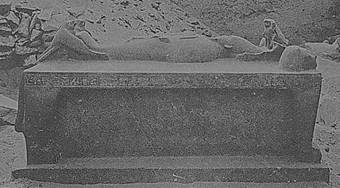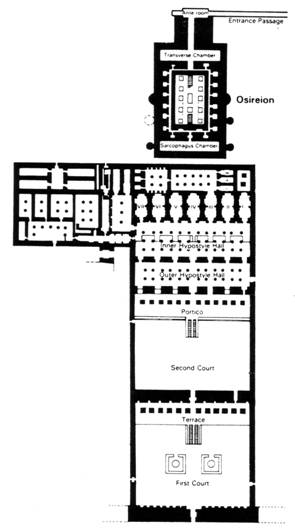




|
Menu |
|
The Temple of Abydos
The main cult temples of Abydos were located inside what is now called the "Osiris Temple Enclosure." The enclosed area measures approximately 76,800 square meters (320 x 240 meters). The archaeological and textual data from the area within the Enclosure is fragmentary and difficult to interpret. Petrie excavated in this area in 1901-03 and found the remains of a series of mudbrick and stone structures as well as many objects; however, the stratigraphic context of much of this data was difficult to trace because of the high water table. Petrie recorded the relative elevations of the artifacts that he recovered, and related these objects to the architectural remains by means of their relative elevation. The architectural remains themselves are difficult to interpret, and some controversy exists as to whether they comprise the remains of the main temple of Osiris-Khentyimentiu or a series of chapels dedicated to the kas ("spirits" or "life forces") of individual kings and elite individuals. The main settlement area of ancient Abydos, like that of the modern region, probably lay to the local east of the Enclosure toward the canal system that linked the site with the Nile.
In the Old Kingdom (ca. 2686-2160 BC) there is evidence that a major temple dedicated to the funerary deity Khentyimentiu ("Foremost of the Westerners") was located within the area of the Osiris Temple Enclosure. That deity was eventually syncretized with Osiris. By the Middle Kingdom (ca. 2055-1650 BC), the Abydos temple had become associated with the god Osiris and gained increased national significance. Osiris was worshipped as a dead and resurrected god and therefore was intimately associated with funerary religion and mortuary practice throughout Egypt. The identification of the dead king with Osiris as ruler of the netherworld further established Osiris as a central figure in the ideology of ancient Egyptian kingship.
Middle Kingdom Complexes
During the Middle Kingdom, a complex of private chapels developed along the escarpment overlooking the route of a festival procession leading from the Osiris temple to Umm el-Ga’ab. Unsystematic excavations within the transitional area at the periphery of the Osiris temple during the last century unearthed a wealth of inscribed limestone stelae and other objects that formed the most durable components of small offering chapels built by Egyptians of many different socio-economic levels to allow for their enduring presence at the site and their eternal participation in the Osiris cult. Many of these stelae express the desire of their dedicators to partake of the offerings given to Osiris in his temple and to participate in the performance of rituals associated with his festival at Abydos. They provide crucial insight into popular religious practice in ancient Egypt. Unfortunately, however, the aims of the excavators of this material were restricted to the procurement of valuable objects for sale to museums and private collectors throughout the world. They did not study the original context in which the artefacts were found, and they considered the mudbrick chapels themselves unworthy of recording. Their methods thus resulted in the loss of a great deal of evidence about the original archaeological context of this important material.
Textual evidence from the Middle Kingdom stelae allows us to reconstruct some aspects of a ritual procession associated with a festival of Osiris, in which an image of the god was carried from the Osiris temple through the low desert to a structure identified as the tomb of the god. The tomb of Osiris was created at the site of the Early Dynastic tomb of Djer at Umm el-Ga'ab, which was restored at this time and provided with a life-sized statue depicting the deceased Osiris lying on a funerary bed, with Isis shown as a hawk hovering over him, at the moment of the conception of their son Horus. |

|
The Osiris Bier, found by Amélineau in the Early Dynastic tomb of Djer at Umm el-Ga'ab and probably dating to the Thirteenth Dynasty |
|
Other elements of the Osiris myth were also re-enacted during the festival, including the struggle that led to Osiris' death. In this sense the performance was similar to the Mediaeval "Mystery Plays" that dramatized the passion of Christ and the Saints within the Christian tradition. According to the Egyptian myth, Osiris was killed by his brother Seth, who coveted his kingship of Egypt. Seth cut the body of his dead brother into pieces and scattered them across the land. Isis, the wife and sister of Osiris, then collected the pieces together and magically revived her deceased husband long enough to conceive a son (Horus). She raised Horus in secret, and when he was old enough he battled with Seth and ultimately brought the case against his uncle to the Divine Tribunal, where the gods heard the evidence and ultimately found in favor of Horus. Horus was instated as the legitimate ruler of Egypt, and Osiris was allowed to rule over the dead in the Netherworld.
The importance of Osiris as the archetype for post-mortem transformation and of the Osiris myth as a metaphor for the journey of the deceased to the blessed afterlife contributed to the growing importance of Abydos as the cult centre of the god. From the Middle Kingdom on, a post-mortem journey to Abydos was often represented in the tombs of non-royal individuals in other parts of Egypt. Inscriptional evidence from stelae originally set up in North Abydos as well as from tombs located elsewhere suggests that Abydos became a true place of pilgrimage by the Middle Kingdom and continued to function in this way during subsequent periods. During the New Kingdom (ca. 1550-1069 BC) individuals continued to build small offering chapels at the edge of the Osiris temple precinct, in order to participate in the cult. However, because the nature of the inscriptions on stelae from these structures changed over time, providing fewer details about the rituals associated with the cult than did those of the Middle Kingdom, popular involvement in the Osiris cult during the New Kingdom has remained poorly understood. The kings of Egypt continued to build, refurbish, and rebuild elements of the Osiris temple complex during this time, and at the very outset of the Eighteenth Dynasty Ahmose I built a pyramid complex in South Abydos. It remains unclear whether Ahmose was actually buried at Abydos, but the complex included a pyramid with associated temple, a tomb in the low desert, and a “terrace temple” located at the base of the high desert cliffs, as well as a number of cult structures dedicated to female members of the royal family, including Tetisheri and Ahmose-Nefertari. During the Nineteenth Dynasty, Seti I constructed a major temple complex at Abydos dedicated to the cult of the deceased king as Osiris. That structure also incorporates a subterranean tomb feature known as the Osireion. Little now remains of a small chapel dedicated to Ramesses I, the founder of the dynasty, next to the Seti I complex. However, the temple that Seti I's son Ramesses II built nearby still stands. The temples of Seti I and Ramesses II at Abydos preserve lists of the rulers of Egypt that are an important source of data for the reconstruction of Egyptian political history. |
|
“Portal” Temple of North Abydos
In addition to the temple that he built near the temple of his father Seti I, Ramesses II also constructed a large cult structure in North Abydos, adjacent to the Osiris Temple Enclosure within the Votive Zone site. That structure has been called the “Portal” Temple, because when Petrie first investigated it he proposed that it was a ceremonial gateway leading from the temple precinct into the North Cemetery. However, subsequent archaeological excavation of the structure by the Penn-Yale Expedition in the 1967-79 have demonstrated that it was a temple rather than simply a gateway. Its architectural layout remains unclear due to the incomplete preservation of the rear or local western portion of the structure. Under the floor level of the structure, a stratum of Middle Kingdom offering chapels was preserved. The investigation of this stratum provided indications of the original context of the stelae and other inscribed artefacts of that date which were removed from the Votive Zone by early excavators at the site. |

|
Plan of the temple of Seti I at Abydos, The Osireion at Abydos |
|
Home | Location | Osiris Cult | Temple | Staff | Research | Site | Votive Chapel |


|
North Abydos Votive Zone Project |
|
Copyright © 2006 Department of Near & Middle Eastern Civilizations, University of Toronto. All rights reserved. |